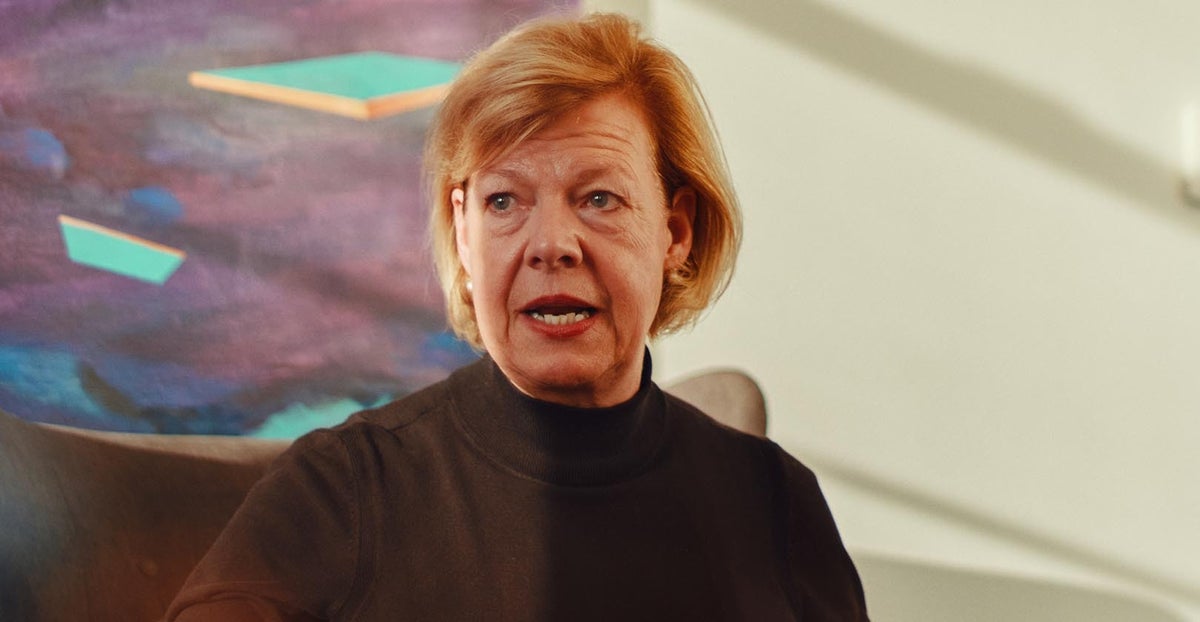FORT ATKINSON, Wis. — Democratic Sen. Tammy Baldwin, a liberal from the most liberal part of Wisconsin, is in Jefferson County, a rural area about an hour west of Milwaukee.
The goal of her Saturday afternoon sojourn to a Democratic canvass kickoff is not to win this pro-Trump part of the state — she could not even do that in 2018, when she romped to a 10-point statewide victory after the GOP essentially gave up on the contest — but to simply lose it by less.
Making rural counties like this one turn light pink on election night instead of dark red is how Baldwin hopes to do something increasingly difficult in American politics: win her state’s Senate race, even if her party’s presidential nominee loses there. Of course, Baldwin would prefer if she and Vice President Kamala Harris both win on Nov. 5, but she is one of a handful of Democrats in a position to outrun the top of the ticket by potentially decisive margins.
“There are a lot of rural voters who may consider splitting their ticket,” Baldwin said in an interview with HuffPost. “They have Trump bumper stickers on their pick-ups and are voting for me.”
Baldwin’s campaign is not overly confident — she noted both President Joe Biden and former President Donald Trump won the state by less than a percentage point, and Republicans are ramping up their spending in the state – but the potential that Wisconsin will choose a Republican president and Democratic senator is part of a clear pattern.
Democrats in Senate battleground races are running ahead of Harris’ margin in the presidential race, a sign of how the party’s standard-bearers have been able to capitalize on sometimes weak GOP opponents and separate themselves from the national Democratic brand. If they succeed, they could prove a potential bulwark against a Republican Senate majority under a second Trump presidency.
In Wisconsin, Baldwin is running about three points ahead of Harris in FiveThirtyEight’s polling averages, a threshold matched by Rep. Elissa Slotkin in Michigan and exceeded by Sen. Bob Casey’s four-point edge in Pennsylvania. In the Southwest, Nevada Sen. Jacky Rosen is running eight points ahead of Harris’ margin, and Rep. Ruben Gallego is running nine points ahead. All of them are also leading their GOP opponents.
Even in the two toughest races for Democratic incumbents, Ohio Sen. Sherrod Brown is running 10 points ahead of Harris’ margin in the Buckeye State, while Montana Sen. Jon Tester is 11 points ahead of her. (While polls indicate Brown could narrowly survive, Tester is trailing Republican businessman Tim Sheehy.)
“It’s about the strength of these candidates,” said Martha McKenna, a former political director at the Democratic Senatorial Campaign Committee. “We bounced from one candidate to another at the top of the ticket, but their standing in their states hasn’t changed.”
The trend is all the more remarkable for how rare ticket-splitting has become. Across the three presidential elections of the 1980s, a whopping 46 senators won their states while a presidential candidate of the opposite party triumphed there, and 23 pulled it off in the two elections of the 1990s. But over the course of the last two presidential cycles, only Sen. Susan Collins (R-Maine) has managed to hang onto a state that the GOP presidential candidate lost.
Having Senate candidates run ahead of her is not troubling for Harris — 15 Democratic Senate candidates ran ahead of former President Barack Obama in 2012, when he won handily. She is still narrowly leading in polling averages in Wisconsin, Pennsylvania, Michigan and Nevada, and either she or Trump could triumph in any of the major swing states. But the relative strength of Democratic Senate candidates, fueled in part by significant fundraising leads, has surprised operatives in both parties.
For now, the focus for Senate Democrats is on races in the Rust Belt. Some polls have shown GOP candidates gaining ground in a mostly-anticipated fashion as less-engaged Republican voters learn about their party’s nominees.
Eric Hovde, the Republican businessman running against Baldwin, told HuffPost he’s pulled some Trump-Baldwin split ticket voters back to his column in recent weeks, which could help him close the gap with the two-term incumbent. He suggested Thursday he could even run slightly ahead of Trump.
“Back in the summer, she was getting a chunk of Trump voters that were voting for her,” he said after speaking at a GOP event in Racine. “But I think as people have gotten to know me and have come to understand where she stands on President Trump, I think that has really collapsed.”
The region’s Senate races share a similar dynamic: A Democrat with at least some history of winning over swing voters is running against a Republican who has either amassed an impressive personal fortune; faces skepticism about their status as an actual resident of the state they’re running in; or both. The Democrat is hammering the Republican on personal issues, while the Republican is running hard on immigration, inflation and GOP culture-war topics.
Between states, the Democratic strategies differ slightly. Brown is relying on his ties to the state’s labor movement to woo the working class in solid-red Ohio. Casey in Pennsylvania is banking on voters’ familiarity with him and decades of trust in his family. Slotkin is hoping her brand of moderation is perfect for Michigan suburbanites.
Baldwin’s path is a little different.
“Her electoral history is one of running ahead of other Democrats in more Republican areas,” said Charles Franklin, who directs the Marquette University Law School poll. “While she’s a very progressive member of the Senate by voting record, she does clearly travel around the state and ask, ‘What can I do for this area?’”
The latest iteration of Franklin’s poll has Baldwin leading by a 53% to 46% margin among likely voters, though other public and private surveys show the race closer. Baldwin is running just slightly ahead of Harris in the Marquette poll, who is leading Trump 52% to 48%.
Baldwin points to a host of reasons she may win over rural voters. Manufacturing communities should love her support of “Buy America” laws, which were the subject of the first TV ad of her campaign; she’s worked to build a new state-owned hospital in tiny Lafayette County in the state’s southeast; and her steadfast support of the dairy industry led to her becoming the first Democrat in 20 years to win the support of the state’s Farm Bureau. In particular, Baldwin has been leading a charge to ban non-dairy products from using the word “milk” in their branding.
Hovde insisted the Farm Bureau would suffer more than he would from its decision to back Baldwin: “Many farmers were upset by that endorsement,” he said.

Caleb Alvarado for HuffPost
While Baldwin is still running ahead of Harris, some polling has shown Hovde gaining ground. Republicans are pouring cash into the race; Hovde, a multi-millionaire, has loaned his campaign $13 million, and Senate Minority Leader Mitch McConnell’s super PAC announced last week they would spend $22.5 million on the race.
“They went all the way to California to find a deep-pocketed opponent to run against me,” Baldwin told the crowd in Fort Atkinson, as attendees snacked on Subway sandwiches, chips and cookies from Kroger and soup warmed up in a Packers-branded crockpot.
“He was named one of Orange County’s most influential residents three years in a row,” she said of Hovde. ”We have a Green County in Wisconsin, we have a Brown County in Wisconsin. We do not have an Orange County.”
(Hovde, whose father was an official in President Ronald Reagan’s administration, was born and raised in Wisconsin and previously ran for Senate there in 2012, losing the GOP primary. He’s the CEO of Sunwest Bank, which was long based in Orange County, California and is now based in Utah.)
Baldwin’s campaign has been hyping up her opponent’s wealth and the GOP’s spending on him. But Republicans aren’t even close to drowning out her campaign’s message, at least on TV.
As of Monday, Baldwin and other Democrats were set to spend $5.3 million on television ads this week, good enough to earn them 14,000 gross ratings points – an industry measure of how many viewers will see an ad. Republicans are set to spend $6.2 million but only get 13,000 gross rating points because more of their spending comes from outside groups, which pay higher advertising rates, and because their candidates and committees book later in the cycle, when advertising time is more expensive.
Baldwin’s TV ads have focused on highlighting past statements from Hovde that make him sound like a rude, distinctly un-Midwestern “jerk.” Those include comments suggesting that people in nursing homes shouldn’t vote, that overweight people should pay more for health insurance, that farmers don’t work especially hard compared to their predecessors and that “females” spend too much time focusing on Hollywood.
The ads end on a catchphrase: “What the hell’s wrong with this guy?”

Caleb Alvarado for HuffPost
Hovde dismisses the attack ads as mere distractions.
“I’ve been focusing my time talking about the issues that matter to people in Wisconsin: Inflation, the open border, our health care crisis that we’re facing in this country,” Hovde told HuffPost. “She keeps making up these silly attack ads calling me a jerk. So I think people see through her ads and want to hear real, meaningful subjects.”
His ads have portrayed Baldwin as a left-wing twin of Harris on major issues.
Baldwin, for her part, clearly sees rising consumer costs as a potential political vulnerability. In an interview, she pointed to her work capping the cost of inhalers and also attacked diaper manufacturers and other big corporations for causing “greedflation.”
And in a state which backed Trump and sent the famously prickly Ron Johnson to the Senate three times, it’s not clear being a “jerk” is an insurmountable political liability.
“People say Hovde is a lot like Trump,” one Democratic strategist who has worked extensively in the state acknowledged. “And they mean that as a bad thing, but there’s ways that’s a good thing for him, politically.”
And then there are the ways the two candidates are interacting with their ticket-toppers. Baldwin was seemingly everywhere in the week leading up to her appearance in Jefferson County — an event in the Madison suburbs with the president of Planned Parenthood, a rally with college students at the University of Wisconsin campus in Whitewater, a small business event in Waukesha — but she was not with Harris.
Two days earlier, Harris had appeared with former Rep. Liz Cheney (R-Wyo.) elsewhere in rural Wisconsin, specifically Ripon — the historic birthplace of the GOP. Baldwin wasn’t there, though she told HuffPost it wasn’t meant as a snub.
“When we get a notice three days beforehand that [Harris or the Democratic vice presidential nominee, Minnesota Gov. Tim Walz] are going to be somewhere, you make a decision of whether you cancel everything from that day to get up there or not,” Baldwin said on Saturday, after appearing on a roundtable with Black elected officials. “We’re going to make that call every time as these opportunities present themselves.”
Hovde, for his part, has sought to appear alongside Trump as often as possible, and to directly tie his fortunes to his party’s leader. The day after the interview in Racine, he jumped up on stage when Trump called on him during a rally in Juneau.
“I always love to be here with President Trump!” Hovde declared, adding: “Let’s get President Trump and me to Washington!”

